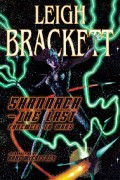Leigh Brackett
(December 7, 1915 – March 18, 1978) A writer of science fiction, mystery novels and — best known to the general public — Hollywood screenplays, most notably The Big Sleep (1945), Rio Bravo (1959), The Long Goodbye (1973) and the first draft of The Empire Strikes Back (1980).
Brackett’s first published science fiction story was “Martian Quest”, which appeared in the February 1940 issue of Astounding Science Fiction. Her earliest years as a writer (1940-1942) were her most productive in numbers of stories written; however, these works show a writer still engaged in mastering her craft. The first of her science fiction stories still attempt to emphasize a quasi-scientific angle, with problems resolved by an appeal to the (usually imaginary) chemical, biological, or physical laws of her invented worlds. As Brackett became more comfortable as an author, this element receded and was replaced by adventure stories with a strong touch of fantasy. Occasional stories have social themes, such as “The Citadel of Lost Ships” (1943), which considers the effects on the native cultures of alien worlds of Earth’s expanding trade empire.
Brackett’s first novel, No Good from a Corpse, published in 1944, was a hard-boiled mystery novel in the tradition of Raymond Chandler. Hollywood director Howard Hawks was so impressed by this novel that he had his secretary call in “this guy Brackett” to help William Faulkner write the script for The Big Sleep (1946). The film, starring Humphrey Bogart and written by Leigh Brackett, William Faulkner, and Jules Furthman, is considered one of the best movies ever made in the genre.
At the same time, Brackett’s science fiction stories were becoming more ambitious. Shadow Over Mars (1944) was her first novel-length science fiction story, and though still somewhat rough-edged, marked the beginning of a new style, strongly influenced by the characterization of the 1940s detective story and film noir. Brackett’s heroes from this period are tough, two-fisted, semi-criminal, ill-fated adventurers. Shadow’s Rick Urquhart (reputedly modelled on Humphrey Bogart’s shadier film characters) is a ruthless, selfish space drifter, who just happens to be caught in a web of political intrigue that accidentally places the fate of Mars in his hands.
In 1946, the same year that Brackett married science fiction author Edmond Hamilton, Planet Stories published the novella “Lorelei of the Red Mist”. Brackett only finished the first half before turning it over to Planet Stories’ other acclaimed author, Ray Bradbury, so that she could leave to work on The Big Sleep. “Lorelei”‘s main character is an out-and-out criminal, a thief called Hugh Starke. Though the story was well concluded by Bradbury, Brackett seems to have felt that her ideas in this story were insufficiently addressed, as she returns to them in later stories—particularly “Enchantress of Venus” (1949).
Brackett returned from her break from science-fiction writing, caused by her cinematic endeavors, in 1948. From then on to 1951, she produced a series of science fiction adventure stories that were longer, more ambitious, and better written than her previous work. To this period belong such classic representations of her planetary settings as “The Moon that Vanished” and the novel-length Sea-Kings of Mars (1949), later published as The Sword of Rhiannon, a vivid description of Mars before its oceans evaporated.
With “Queen of the Martian Catacombs” (1949), Brackett found for the first time a character that she cared to return to. Brackett’s Eric John Stark is sometimes compared to Robert E. Howard’s Conan, but is in many respects closer to Edgar Rice Burroughs’ Tarzan or Rudyard Kipling’s Mowgli. Stark, an orphan from Earth, is raised by the semi-sentient aboriginals of Mercury, who are later killed by Earthmen. He is saved from the same fate by a Terran official, who adopts Stark and becomes his mentor. When threatened, however, Eric John Stark frequently reverts to the primitive N’Chaka, the “man without a tribe” that he was on Mercury. Thus, Stark is the archetypical modern man—a beast with a thin veneer of civilization. From 1949 to 1951, Stark (whose name obviously echoes that of the hero in “Lorelei”) appeared in three tales, all published in Planet Stories; the aforementioned “Queen”, “Enchantress of Venus”, and finally “Black Amazon of Mars”. With this last story Brackett’s period of writing high adventure ends.
Brackett’s stories thereafter adopted a more elegiac tone. They no longer celebrate the conflicts of frontier worlds, but lament the passing away of civilizations. The stories now concentrate more upon mood than on plot. The reflective, retrospective nature of these stories is indicated in the titles: “The Last Days of Shandakor”; “Shannach — the Last”; “Last Call from Sector 9G”. This last story was published in the very last issue (Summer 1955) of Planet Stories, always Brackett’s most reliable market for science fiction. With the disappearance of Planet Stories and, later in 1955, of Startling Stories and Thrilling Wonder Stories, the market for Brackett’s brand of story dried up, and the first phase of her career as a science fiction author ended. A few other stories trickled out over the next decade, and old stories were revised and published as novels. A new production of this period was one of Brackett’s most critically acclaimed science fiction novels, The Long Tomorrow (1955). This novel describes an agrarian, deeply technophobic society that develops after a nuclear war.
But most of Brackett’s writing after 1955 was for the more lucrative film and television markets. In 1963 and 1964, she briefly returned to her old Martian milieu with a pair of stories; “The Road to Sinharat” can be regarded as an affectionate farewell to the world of “Queen of the Martian Catacombs”, while the other – with the intentionally ridiculous title of “Purple Priestess of the Mad Moon” – borders on parody.
After another hiatus of nearly a decade, Brackett returned to science fiction in the seventies with the publication of The Ginger Star (1974), The Hounds of Skaith (1974), and The Reavers of Skaith (1976), collected as The Book of Skaith in 1976. This trilogy brought Eric John Stark back for adventures upon the extrasolar planet of Skaith (rather than his old haunts of Mars and Venus). A fourth Stark novel was planned with Ballantine Books editor Lester del Rey, but was abandoned (and no actual manuscript was begun) when Brackett was offered the scipting duty for the sequel to Star Wars.
Most of Brackett’s science fiction can be characterized as space opera or planetary romance. Almost all of her planetary romances take place within a common invented universe, the Leigh Brackett Solar System, which contains richly detailed fictional versions of the consensus Mars and Venus of science fiction in the 1930s–1950s. Mars thus appears as a marginally habitable desert world, populated by ancient, decadent, and mostly humanoid races; Venus as a primitive, wet jungle planet, occupied by vigorous, primitive tribes and reptilian monsters. Brackett’s Skaith combines elements of Brackett’s other worlds with fantasy elements.
The fact that the settings of Brackett’s stories range from a rocket-crowded interplanetary space to the superstitious backwaters of primitive or decadent planets allows her a great deal of scope for variation in style and subject matter. In a single story, Brackett can veer from space opera to hard-boiled detective fiction to Western to the borders of Celtic-inspired fantasy. Brackett cannot, therefore, be easily classified as a sword-and-planet science fantasy writer; though swords and spears may show up in the most primitive regions of her planets, guns, blasters and electric-shock generators are more common weapons.
Though the influence of Edgar Rice Burroughs is apparent in Brackett’s Mars stories, the differences between their versions of Mars are great. Brackett’s Mars is set firmly in a world of interplanetary commerce and competition, and one of the most prominent themes of Brackett’s stories is the clash of planetary civilizations; the stories both illustrate and criticize the effects of colonialism on civilizations which are either older or younger than those of the colonizers, and thus they have relevance to this day. Burroughs’ heroes set out to remake entire worlds according to their own codes; Brackett’s heroes (often anti-heroes) are at the mercy of trends and movements far bigger than they are.
—adapted from the Wikipedia entry on Leigh Brackett


